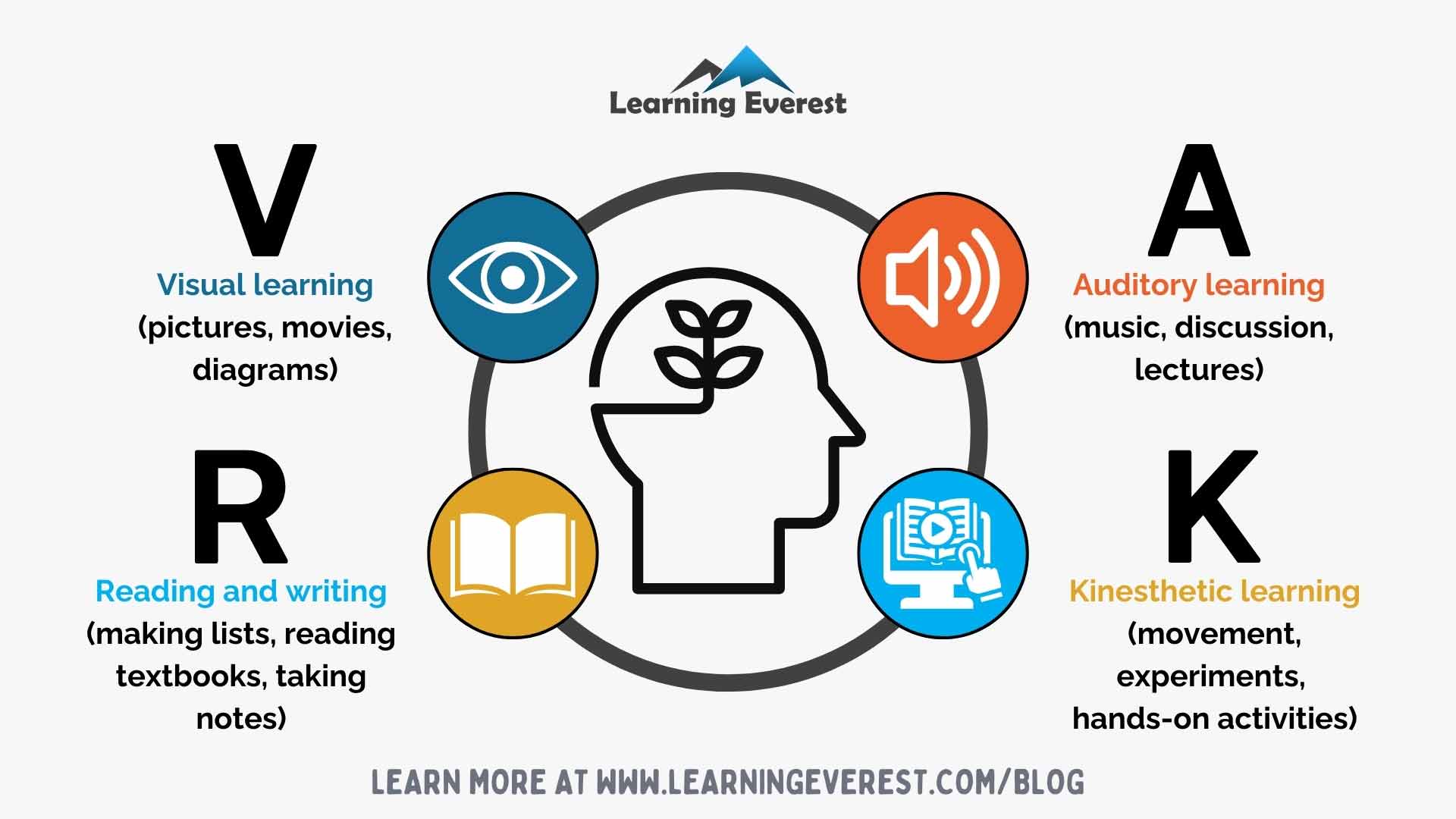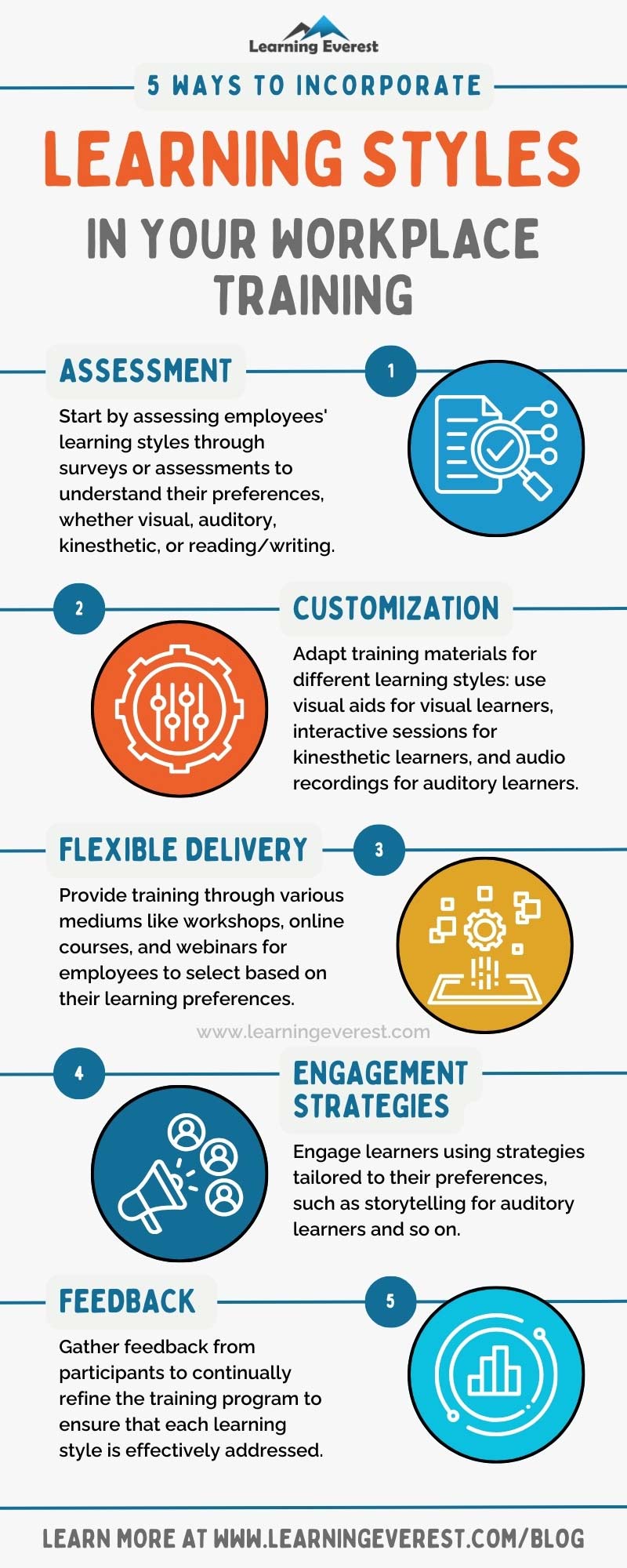Training is and should be for everyone, regardless of the different types of learning styles. To accommodate different types of learning styles at work, you need to first know how your employees learn. In this blog, we will explore different learning styles and ways to incorporate them in your workplace.
Table of Contents
- What are the different types of learning styles?
- 4 different types of learning styles according to the VARK model:
- Tips for creating an inclusive training program
- Conclusion
- Infographic
- Knowledge Check!
- Frequently Asked Questions (FAQs)
- Q: What are the different types of learning styles?
- Q: What are the 4 types of learning?
- Q: Why is the VARK model important?
What are the different types of learning styles?
Different types of learning styles are instructional approaches that utilize multiple sensory modalities to enhance a learner’s learning experience. It is a way of identifying that individuals have different learning styles and preferences and, therefore, incorporating a mix of visual, auditory, kinesthetic, and all other types of interactive elements to engage learners and facilitate a deeper understanding of the knowledge. By presenting information through different types of learning styles, it aims to cater to the diverse needs/preferences of learners and optimize comprehension, retention, and application of knowledge.
There has been much discussion about identifying the different types of learning styles. The concept was established around the 1970s, and in 1987, Neil D. Fleming, a New Zealand educationalist, created the first questionnaire, VARK, to help identify different types of learning styles. The VARK model by Neil D. Fleming classifies learner preferences into four categories – visual, auditory, reading/writing, and kinesthetic. This is the birthplace of the idea of different types of learning styles. Each learning style represents a preferred mode of receiving and retaining information.
4 different types of learning styles according to the VARK model:

4 Different types of learning styles according to the VARK model
Here is a breakdown of each of the four VARK learning styles:
1. Visual learning
Visual learning involves learning by seeing. It includes using visual aids like infographics, charts, drawings, videos, and maps to engage the learner’s visual senses. Employing strategies like highlighting with colors, varying text styles, and marking key points with symbols are integral to visual learning.
2. Auditory learning
Auditory learning focuses on training learners through listening. It integrates auditory elements into training programs through means such as podcasts, face-to-face learning, group discussions, interviews, and audiobooks.
3. Reading & writing learning
This traditional method involves absorbing information through text. It’s typically incorporated into training through textual materials like books, eBooks, articles, PDFs, and written examinations.
4. Kinesthetic learning
The kinesthetic learning style involves learning through activity. Learning in this mode is hands-on, involving physical activities. Training might include practical experiences like site tours, product demonstrations, or interactive presentations. Kinesthetic learning is often combined with visual and auditory methods to enrich the learning experience.
So, how can you best accommodate each of these different types of learners in an employee training program?
Tips for creating an inclusive training program
To ensure your training caters to all learning styles in the workplace, you need access to the correct data from your employees. The data will tell you where your employees need assistance, how much they achieve the objectives of a training course, and how much knowledge/skill they retain in the long run. You also need to have the right tools to build all these elements that accommodate different types of learning styles — from microlearning videos to infographics and other training resources. In other words, you need to build an effective training platform that can help you create an inclusive learning journey in the workplace.
The following are some tips for ensuring your workplace training program is inclusive of a diverse workforce.
1. Assess Needs
Assessing needs involves gathering information about your employees’ individual learning preferences, needs, and cultural backgrounds to create a training program that is effective for everyone. This helps tailor the training to suit various learning styles and backgrounds. Imagine a company with a diverse workforce that includes employees of different ages, ethnicities, cultural backgrounds, and job roles. To ensure that a new training program is effective, the company needs to conduct a survey. The survey asks employees about their preferred learning methods, previous knowledge of the topic, and the times they are most likely to engage with training materials.
2. Invest in an amalgamated learning model
Trying to accommodate all different types of learning styles in the workplace may feel like a hectic task, but the answer is simple. The best thing you can do is use a combination of learning, which involves combining techniques from each of the four learning styles.
For instance, one training module can include one instructor-led session (virtual pre-recorded, with the transcript made available), animated microlearning videos with subtitles, infographics, reading material, real-life simulations, gamified summative/formative assessments, collaborative assignments, etc. In this way, there’s something for each and everyone, and no one learner style has an unfair advantage over the others.
3. Focus on the learner engagement
Often, when you’re training a large group of employees, you don’t know each person’s learning needs. However, people use their senses to engage with the training content. And the more you can make them engaged with the training content, the more they learn and retain. So, ensure your training allows learners to express themselves and be actively involved with the training material.
You can add quizzes or short gamified exercises that ask learners to participate, drag and drop, or do certain activities using the knowledge they just learned. You could allow them to record a video or audio answer to an assignment. You can even create dedicated spaces (i.e., online discussion forums) where learners can connect and interact with each other and also with their instructors. Implement a system for continuous feedback, allowing trainers to adjust the program based on the learners’ experiences and suggestions.
4. Strike a balance between self-paced and structured learning
Balancing self-directed and structured learning is key, especially as remote work requires employees to adjust their schedules. A structured approach provides necessary guidance, while self-paced learning accommodates individual needs. For instance, you might offer live webinars (synchronous learning) alongside recorded sessions and interactive exercises (asynchronous learning) that your employees can access at their convenience. This strategy respects employees’ time constraints and supports different types of learning styles. Additionally, allowing learners to revisit courses ensures they can reinforce and retain the information through repetition and practice.
Conclusion
Although these different types of learning styles can tell us a lot about how individuals communicate and absorb information, it’s important to remember that they are not set in stone. Learning styles can evolve or change as people grow up, and different types of learning can become more dominant in different contexts. This adaptability reassures us that we can always find the best way to learn and teach.
Improve your employee training with our industry-ready eLearning courses. Book a demo now!
Infographic

5 Ways to incorporate Learning Styles in your workplace training
Knowledge Check!
Frequently Asked Questions (FAQs)
Q: What are the different types of learning styles?
A: Different types of learning styles are instructional approaches that utilize multiple sensory modalities to enhance a learner’s learning experience.
Q: What are the 4 types of learning?
A: Named the VARK model of learning, Neil D. Fleming theorized that we all have one of four main learning styles: visual, auditory, reading/writing, and kinesthetic.
Q: Why is the VARK model important?
A: The VARK model can be used by educators to help with strategies for planning and promoting learning based on their type of learning style.





